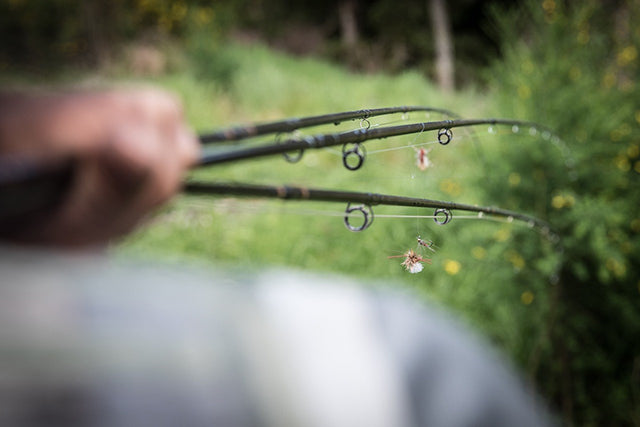Techy Thursday - Dry & Dropper Rig

It would be safe to say that if you fly fish then it’s very likely you have fished the dry dropper rig before. It’s a tried and true method that gives the fish the option of both offerings, being the dry fly and nymph. With the dry fly acting as an indicator also it is easy to vary the size and buoyancy to suit the conditions and situation you are presented with. Commonly the dropper is tied to the shank of the hook but can also attached via a surgeon’s tag.
Below is a break down of the system and how to best fish this:
DROPPER LENGTH
This varies depending on the situation, make your calculation based on the weight of fly you have chosen, water speed, depth & density. For example, if you choose a medium weighted nymph your target fish is sitting in 2 feet of water which is riffled and aerated. This would require a short dropper of a foot or two and the cast would only need a short lead. Where as a fish holding deep in the body off the pool with the water being denser requires a heavier nymph and a larger dropper length distance between dry fly and nymph. The fly will need to lead the fish further in order to give time for the fly to sink down into the zone. Be careful not to select a fly too heavy for the job where the fly bottoms out before covering the fish. This can be controlled by adjusting the length of the dropper.

Hi Viz PMX
FLY VISIBILITY
Choose the fly that suits the conditions and situation. Visibility is very important where missing takes through not being able to see the fly is unproductive. The terrestrial time of year is great where you can use large patterns that incorporate large wings and hi viz sight posts which makes for easy tracking and indication.

Parachute Adams
BOUYANCY
This comes down to what the fly is made of also how it is tied. Heavy hackled, foam bodied and synthetic deer hair winged flies are very buoyant options which do a great job of suspending heavy weighted nymphs throughout the drift. Select your dry based on the nymph weight for the job and water conditions. A Parachute Adams #14 is a great choice for holding up an unweighted or lightly weighted nymph and is good for a lot of situations. However, if you add a heavier tungsten bead head fly to this and pitched it into some heavy water it is very likely to be pulled under before the drift has finished. The key here is selecting your fly and its buoyancy to suit the nymph weight and fishing situation.

Death Metal Pheasant Tail
STEALTH
Fish can get precious at times, especially in low water conditions, so having a stealthier more subtle approach can really pay off. A small subtle dry with a small nymph is a more discrete way of covering your target fish and will often result in an eat as opposed to the fish spooking from the large object in their space.

CASTING
Large bushy dry flies can be a challenge to cast due to the nature of their size and wind resistance. Avoid having an overly long leader length, make it so you have enough separation from fly and line in order to cover the fish without lining it and that’s enough. This will keep you more in touch with the flies during the cast. Be sure to allow your back cast to fully unravel as this will restore the energy for the forward cast. On the forward cast haul positively and turn the wrist right over, this keeps everything tight for positive turn over.
